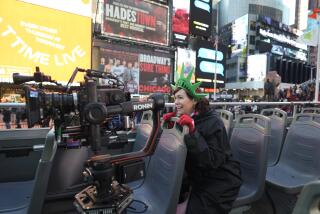Buenos Aires has new role
BUENOS AIRES — In sync with cranking 1970s funk, a black Cockney cab blows past a cafe full of well-heeled Londoners, leaving them choking on billows of smoke.
Although the blazing-red telephone booth and signs reading “Thurpton and Book Streets” may look like England, London is far away. Argentina’s pink presidential palace is only around the corner. And the scene is from a TV commercial.
Buenos Aires is fast becoming a South American Hollywood, thanks to a devalued currency, European flair and low-cost talent.
“This corner really feels like London,” said Enrique Bertoglio, an Argentine office worker who gawked at the impromptu English street signs plastering the corner of Roca and Alsina streets. “It looks like another country.”
From Britain, Russia and the United States -- and a lot of other places -- filmmakers are coming to Argentina.
Robert Redford’s production company recently shot scenes in Buenos Aires for its movie “The Motorcycle Diaries,” about Che Guevara. Spanish and Italian movie productions also have been spotted on the city’s European-inspired boulevards.
Then there are the crews out filming television commercials.
The London street scene staged for Clarks, a British shoemaker, is one of hundreds of TV commercials that have been shot in Buenos Aires in recent months for big-name brands such as Budweiser, Coca-Cola, L’Oreal and Proctor & Gamble.
Mariano Fernandez Bussy, director of Buenos Aires’ fledgling film commission, said the appeal of the Argentine capital of 13 million is its varied architecture: Buenos Aires can mask itself as Rome, Madrid or any other world city.
“If it is a French crew, they can easily re-create the feeling of Paris. If they are from the U.S., they can choose parts like New York,” Bussy said.
But until last year, Argentina’s cinematographic beauty came at a price more than threefold today’s costs. For more than a decade, Argentina’s peso was tied to the dollar, making Buenos Aires as expensive as shooting in Europe or the U.S.
Then came December 2001: Chaotic protests springing from a failing economy erupted across Argentina and brought a steep devaluation that ended the dollar’s reign. Riots and looting kept away foreign film crews.
“But when they finally came, they saw that the country was not up in flames,” said local producer Raul Outeda, who worked with Emma Thompson and Antonio Banderas in Buenos Aires on parts of their upcoming movie “Imagining Argentina,” about the country’s past dictatorship.
Although the unrest has been quelled, the peso’s plight has turned Argentina and the city of Buenos Aires into seemingly one sprawling studio brimming with international clients.
Filming around Buenos Aires has doubled since January 2002. Government figures show a 20% increase in foreign commercials being filmed in Argentina since July. Today, at least half of the two commercials shot daily are for foreign clients.
Expenses for filming in Argentina can run at least 20% lower than those in Canada, South Africa and New Zealand.
But there is more than just the economic draw. Argentina has a strong film tradition and the latest equipment. Benefiting from years of state support, the film industry can supply well-trained talent behind and in front of the camera.
The unending stream of requests to shoot is rescuing an industry nearly decimated by Argentina’s five years of economic recession.
According to the Argentine actors guild, salaries on foreign-backed commercials, documentaries or feature films are up to eight times more than those earned on local work -- and they are paid in dollars.
Alejandro Suaya of Atomic Films said he envisions Buenos Aires becoming a “factory town” for international film productions. Suaya said he is now in talks with film executives in Los Angeles about shooting more movies in Buenos Aires.
“Right now, Argentina is hot,” he said. “We have to make it stay that way.”
More to Read
Sign up for Essential California
The most important California stories and recommendations in your inbox every morning.
You may occasionally receive promotional content from the Los Angeles Times.










